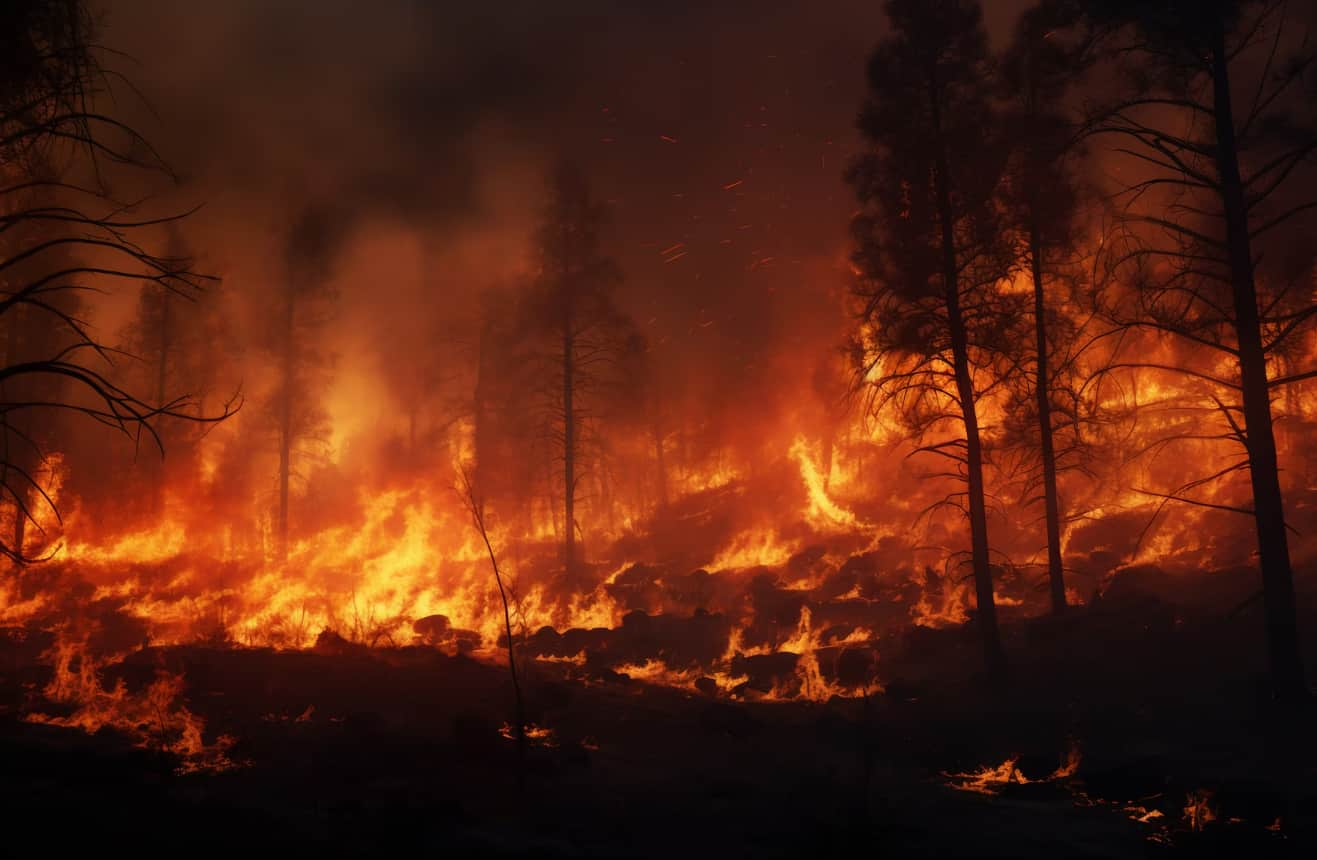The latest huguette lake forest fire represents one of the most significant environmental disasters of 2023.
What began as a seemingly containable fire on August 12, 2023, quickly evolved into an unstoppable force that has forever changed the landscape around Huguette Lake.
The fire’s rapid spread, fueled by a perfect storm of drought conditions, strong winds, and extremely dry vegetation, has destroyed more than 200,000 acres of pristine wilderness, making it one of the largest wildfires in recent history.
The impact of this devastating fire extends far beyond the visible destruction of trees and buildings.
It has disrupted entire ecosystems, forced thousands of residents to abandon their homes, and challenged our understanding of modern firefighting techniques.
The Latest Huguette Lake Forest Fire

The fire’s intensity has tested the limits of our emergency response systems, while its scope has highlighted the growing concerns about climate change and its role in making wildfires more frequent and severe.
As firefighters continue their relentless battle against the flames, achieving 85% containment as of October 9, 2023, the story of this fire serves as both a warning and a lesson.
It reminds us of nature’s raw power and our responsibility to protect and preserve our wilderness areas for future generations.
The Origins of the Latest Huguette Lake Forest Fire
Understanding how this devastating fire began is crucial for preventing similar disasters in the future.
Potential Causes Under Investigation:
- Lightning Strike Possibility:
- Time of strike: Early morning hours
- Weather conditions: Dry thunderstorm activity
- Location: Remote wilderness area
- Initial response time: Delayed due to terrain
- Human Activity Considerations:
- Campfire regulations in effect
- Recreational activities in the area
- Equipment use restrictions
- Access points and trail usage
Contributing Environmental Factors:
| Factor | Impact Level | Details |
| Drought | Severe | 3+ years of below-average rainfall |
| Temperature | Extreme | 15°F above the seasonal average |
| Wind Speed | High | Gusts up to 45 mph |
| Fuel Load | Critical | Dense, dry vegetation |
| Humidity | Very Low | Below 15% for extended periods |
Early Fire Development:
- First Hour:
- An initial spark in a remote area
- Rapid spread through dry brush
- Limited access for first responders
- Smoke visible from nearby communities
- First 24 Hours:
- The fire grew to over 1,000 acres
- Multiple spot fires developed
- Emergency response mobilized
- First evacuations ordered
- First Week:
- The fire perimeter expanded rapidly
- Multiple fire fronts developed
- An incident command system established
- Regional resources deployed
The Devastation of Huguette Lake: A Landscape Scorched
The fire’s impact has been unprecedented in both scope and intensity.
Ecological Impact Assessment:
- Forest Destruction:
- Old-growth trees lost: Estimated 50,000+
- Rare species habitat destroyed: 15 known locations
- Canopy cover reduced: 85% in affected areas
- Soil structure changed: Top layer severely damaged
- Wildlife Displacement:
- Large mammals affected:
- Deer populations scattered
- Bear habitats destroyed
- Mountain lion territories disrupted
- Bird species impacted:
- Nesting sites destroyed
- Migration patterns disrupted
- Food sources eliminated
- Large mammals affected:
Infrastructure Damage Statistics:
| Type | Number Affected | Estimated Cost |
| Homes | 450+ | $150+ million |
| Commercial Buildings | 35 | $25+ million |
| Public Facilities | 12 | $40+ million |
| Roads & Bridges | 28 miles | $15+ million |
| Power Infrastructure | 75 miles | $30+ million |
Environmental Health Concerns:
- Air Quality:
- Particulate matter levels: 10x normal
- Visibility reduced to <1 mile
- Health advisories issued
- Long-term respiratory concerns
- Water Quality:
- Ash contamination in streams
- pH levels altered
- Aquatic life threatened
- Drinking water concerns
Evacuations and Safety Measures: A Community Under Threat
The emergency response to protect human life has been massive and complex.
Evacuation Statistics:
| Phase | People Evacuated | Area Covered | Duration |
| Initial | 5,000+ | 25 sq miles | 48 hours |
| Secondary | 7,500+ | 40 sq miles | 5 days |
| Tertiary | 3,000+ | 15 sq miles | 3 days |
Emergency Response Network:
- Immediate Actions:
- Early warning systems activated
- Emergency broadcast alerts
- Door-to-door notifications
- Social media updates
- Community sirens activated
- Support Services:
- Emergency shelters: 12 locations
- Medical triage centers: 5 sites
- Pet/livestock facilities: 8 locations
- Food distribution points: 15 centers
- Mental health services: Multiple providers
Community Support Initiatives:
- Short-term Assistance:
- Emergency housing vouchers
- Food and water distribution
- Medical supply access
- Transportation assistance
- Child care services
- Long-term Support:
- Housing placement programs
- Job relocation services
- School enrollment assistance
- Insurance claim support
- Rebuilding consultations
Battling the Blaze: Firefighting Efforts and Resources
The firefighting operation has been one of the largest in recent history.
Personnel Deployment:
| Type | Number | Primary Role |
| Firefighters | 1,200+ | Direct fire combat |
| Support Staff | 500+ | Logistics and planning |
| Medical Teams | 75+ | Emergency care |
| Aviation Crews | 100+ | Aerial operations |
| Command Staff | 50+ | Strategic management |
Equipment and Resources:
- Ground Operations:
- Fire engines: 125 units
- Water tenders: 45 units
- Bulldozers: 35 units
- Command vehicles: 75 units
- Support vehicles: 200+ units
- Aerial Resources:
- Large air tankers: 8
- Medium helicopters: 12
- Light helicopters: 6
- Observation aircraft: 4
- Drone units: 10
Firefighting Strategies:
- Containment Methods:
- Fire line construction
- Backburn operations
- Spot fire monitoring
- Structure protection
- Water drop coordination
- Resource Management:
- Water source mapping
- Fuel break planning
- Personnel rotation
- Equipment maintenance
- Supply chain coordination
The Latest Huguette Lake Forest Fire: A Continuing Threat
Despite progress, significant challenges remain.
Current Status Overview:
- Containment Progress:
- North line: 95% contained
- East line: 90% contained
- South line: 80% contained
- West line: 75% contained
- Active Threat Areas:
- Hot spots: 25+ locations
- Uncontained edges: 15 miles
- Vulnerable structures: 200+
- Critical infrastructure: 8 sites
Recovery Planning:
| Phase | Timeline | Focus Areas |
| Immediate | 0-3 months | Safety and stabilization |
| Short-term | 3-12 months | Infrastructure repair |
| Mid-term | 1-3 years | Ecosystem restoration |
| Long-term | 3-10 years | Forest regeneration |
Future Considerations:
- Environmental Recovery:
- Soil stabilization projects
- Watershed protection
- Wildlife corridor restoration
- Native species replanting
- Invasive species management
- Community Rebuilding:
- Housing reconstruction
- Infrastructure improvements
- Economic revitalization
- Community planning
- Disaster preparedness
FAQs: Latest Huguette Lake Forest Fire
Q: How did the Latest Huguette Lake Forest Fire start?
A: While the exact cause remains under official investigation, investigators are focusing on two primary possibilities:
- Natural Causes:
- Lightning strikes recorded in the area
- Dry thunderstorm activity reported
- Weather conditions documented
- Human Factors:
- Recreational activities in the region
- Equipment use in surrounding areas
- Campfire activities before the incident
The investigation is complicated by:
- Extensive fire damage to the origin site
- Multiple ignition points identified
- Complex weather patterns during ignition
- Limited eyewitness accounts
Q: What is the latest update on the Huguette Lake wildfire?
A: As of October 9, 2023, the situation stands at:
- Containment Status:
- Overall containment: 85%
- Active fire zones: 15%
- Secured perimeter: 200+ miles
- Hot spots being monitored: 25+
Q: What has been the impact of the Latest Huguette Lake Forest Fire on the environment?
A: The environmental impact has been extensive and multi-faceted:
Immediate Environmental Effects:
- Forest Damage:
- 200,000+ acres burned
- Old-growth trees destroyed
- Understory vegetation eliminated
- Soil structure altered
- Wildlife Impact:
- Major species displaced
- Migration patterns disrupted
- Breeding grounds destroyed
- Food sources eliminated
Q: What has been the impact of the Latest Huguette Lake Forest Fire on human communities?
A: The human impact has been significant and far-reaching:
Direct Community Effects:
- Housing Impact:
- Homes destroyed: 450+
- Homes damaged: 700+
- Displaced residents: 15,000+
- Temporary housing needed: 3,000+ units
- Economic Impact:
- Business closures: 100+
- Job losses: 1,500+
- Tourism revenue lost: $25+ million
- Property value decline: 15-30%
Q: What precautions should residents take during wildfire season?
A: Essential precautions include:
Emergency Preparedness:
- Create an Emergency Kit:
- Three-day water supply
- Non-perishable food
- First aid supplies
- Important documents
- Battery-powered radio
- Develop an Evacuation Plan:
- Multiple escape routes
- Family meeting points
- Emergency contact list
- Pet evacuation strategy
- Important item checklist
Q: How is climate change affecting wildfire patterns?
A: Climate change is significantly influencing wildfire behavior:
Observable Changes:
- Weather Patterns:
- Longer dry seasons
- More frequent heat waves
- Reduced rainfall
- Stronger winds
- Vegetation Changes:
- Drier forest conditions
- More dead vegetation
- Changed growth patterns
- Invasive species spread
Q: What resources are available for affected residents?
A: Multiple support systems are in place:
Immediate Assistance:
- Government Aid:
- FEMA assistance
- State emergency funds
- Local relief programs
- Housing vouchers
- Community Support:
- Red Cross services
- Local charities
- Religious organizations
- Volunteer groups
More Popular News:
- Three Brothers Drown Near Southern Memorial Gardens in Baton Rouge
- Kelly Bates Asks Supporters Not to Take Out Their Anger on NBC 10 …
- Argyle Middle School Principal Dies in Accident
Conclusion:
The Latest Huguette Lake Forest Fire represents more than just a natural disaster; it’s a wake-up call about the increasing threats posed by climate change and the need for better forest management practices.
While the immediate crisis may be approaching containment, the long journey of recovery is just beginning.
This event has demonstrated both the devastating power of nature and the remarkable resilience of communities coming together in times of crisis.
The lessons learned from this fire will influence forest management, emergency response procedures, and community planning for years to come.
As we move forward, it’s crucial to remember that preventing such disasters requires both individual responsibility and collective action to protect our natural resources and communities.



